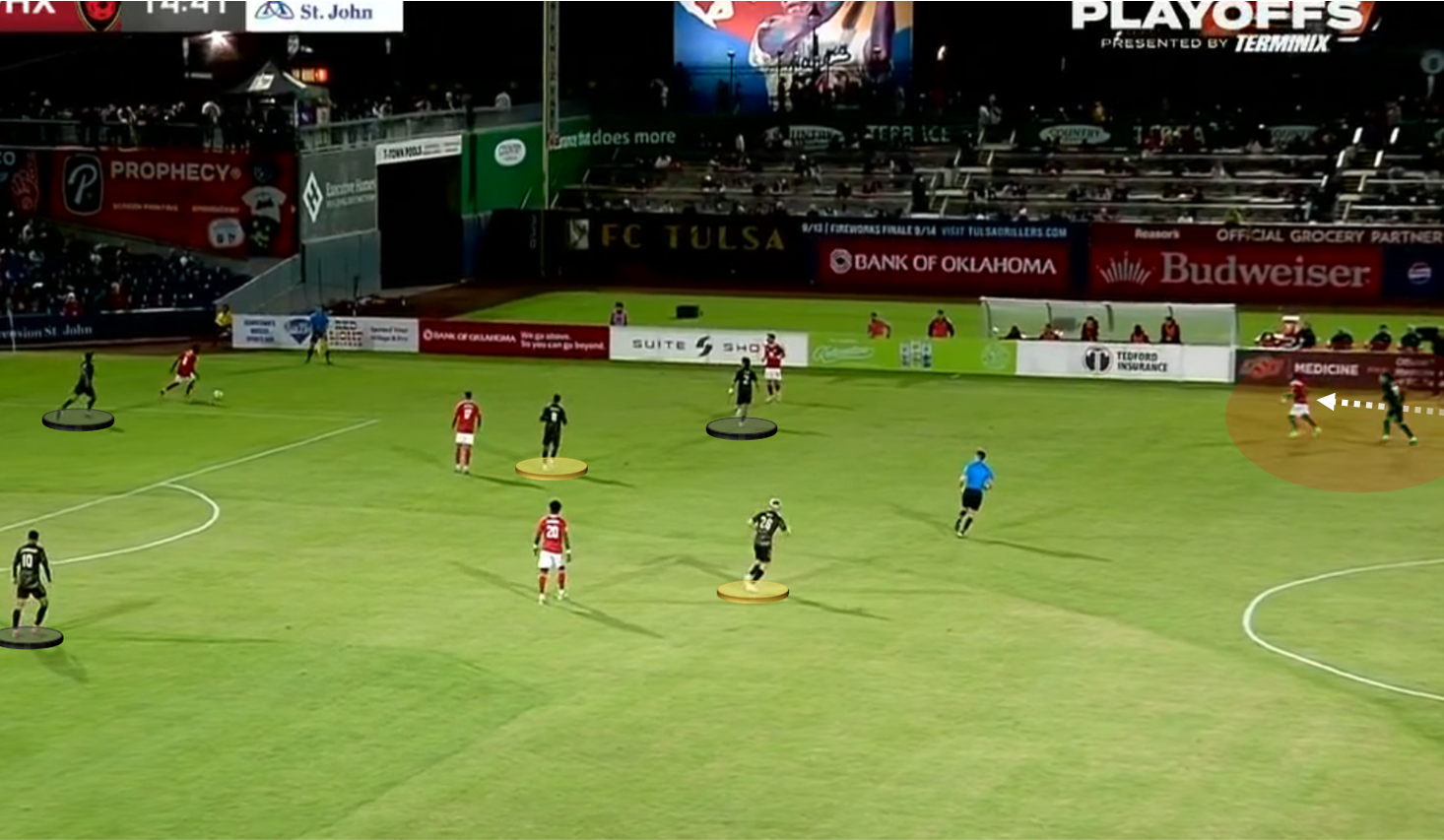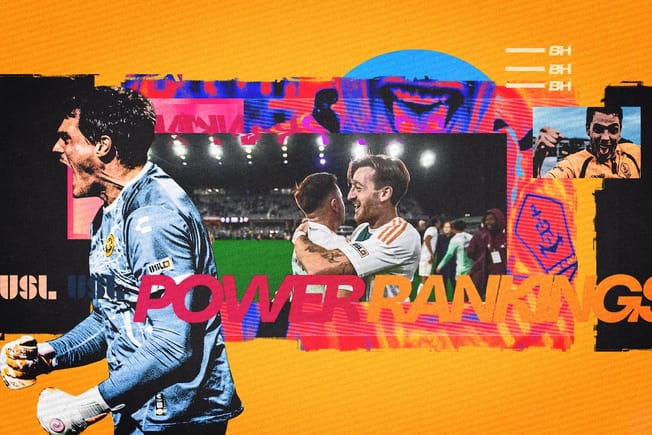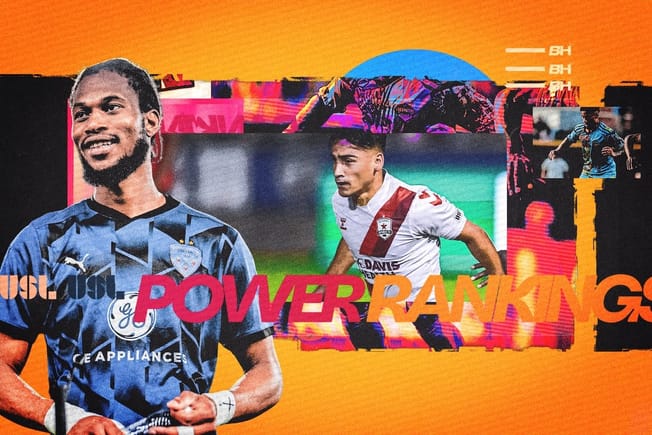If you’re looking for late drama, the USL Championship playoffs have you covered. Two of this weekend’s four games were essentially decided on the last kick. Another went to a penalty shootout, and the “least” dramatic match took 81 minutes to find a cathartic winner. The defensive trends we saw in the first round didn’t go away, but the clubs that combined solidity with pragmatic in-game changes were able to advance.
With the playoff field down to four teams, which of the remaining contenders are in the best position to win it all? I’m ranking the conference finalists, explaining how they got the job done, and eulogizing the teams we lost. Let’s dig in.
1. New Mexico United
Result: 2-1 win v. Orange County
No team in the USL entered the conference semis in better form than New Mexico United. They put in the first round’s best performance last weekend, slicing through San Antonio to extend what became an eight-match unbeaten streak. The closest run-in during that stretch? A 3-3 home draw against Orange County, Saturday’s combatant for the right to advance to the Western Conference Final.
That game was decided in transition, with New Mexico struggling to contain the break after turnovers in the offensive zone. Talen Maples’ move from central defense to right back has helped the cause since then, but Dennis Sanchez flexed a host of structural improvements in the rematch against OCSC.

In advanced possession, United typically kept Gedion Zelalem – their primary holding midfielder, marked in black above – low and left in the vein of a third center back. Doing so was doubly beneficial. Defensively, Zelalem instantly lent an extra pair of feet in the resting shape amidst a crucial matchup against Bryce Jamison. Offensively, he and right-sided center back Kipp Keller could operate as halfspace initiators; their two-way sharpness let New Mexico fan their fullbacks upfield, providing crucial width to prevent OCSC from getting too compact.
Sanchez pushed the envelope as the match went on, pulling starting left back Chris Gloster for the spunkier Jaylin Lindsey (good for 50% more shots and box touches per 90 this season) out of halftime. The aim was to bolster United’s counter, and the payoff was immediate. In the 49th minute, Lindsey led a transition through the Orange County counterpress that culminated into an outlet pass to winger Dayonn Harris. Harris ended the match going a massive five-for-seven on the dribble, and he turned Lindsey’s service into a corner kick. OCSC would clear the initial cross, but Lindsey was in position to recover it, knock the ball back into the box, and let New Mexico grit their way into a lead.
Orange County managed to equalize from a corner of their own, but Sanchez – electing not to make another change in regulation – trusted his starting core to come good. In the 93rd minute, that trust paid off. Zelalem served as the initiator out of the base shape we already saw, ripping a diagonal toward Harris’ flank to set up an absolute screamer on what was effectively the last kick of the game.
It was a moment of utter quality from Harris, but it was also the desired result of the New Mexico gameplan. This club understands how to maximize their talent, including players like Lindsey (a starter for most of the year, now an impact super-sub) and Harris (who was deep on the bench in the spring). That growth is a credit to Sanchez. It explains New Mexico’s red-hot form, and it’s why they remain the title favorite.
2. Rhode Island FC
Result: 2-0 win at North Carolina
History goes out the window in the postseason, but Rhode Island had to feel confident entering Saturday. They’d never lost to North Carolina in the weekend, and their opponent had shockingly announced an impending hiatus on Tuesday. That context would’ve encouraged a lesser manager to try and pounce, but Khano Smith ran back a near-unchanged lineup from last weekend’s win at Charleston to get the job done in Cary.
Rhode Island’s defense deserves primary notice. Smith stuck with Clay Holstad as an attacking mid, retaining a pressing shape that mostly operated like a 5-2-3 but brought ample range through the midfield. Central control came with a trade-off, in that front-to-back compression gave striker Oalex Anderson space to run in behind. RIFC held stars Mikey Maldonado and Pedro Dolabella to merely one chance created, but they allowed Anderson to take 11 box touches – the third-most he’s ever mustered in a decade-long USL career.
The onus was on Rhode Island to work inside-out without turning the ball over and, therefore, setting up short-field breaks. At best, long passes into JJ Williams or driven service to Noah Fuson could set the table for a three-on-two against the rival center backs. Accessing the attacking zone between the lines of NCFC’s 4-4-2 was hardly so rote; Fuson had a particularly uncomfortable time receiving under pressure. Incompletions on the edge of the attacking third were deadly, immediately giving NCFC the chance to rip upfield on the counter.
And THAT is why you bring Albert Dikwa in off the bench.
— John Morrissey (@usltactics.com) 2025-11-09T01:50:42.763Z
Smith waited to make changes, but they couldn’t have been more impactful. Dwayne Atkinson was the first entrant, blending vertical speed with mazy carriage off the bench. Albert Dikwa came next, shifting the look into more of a 5-3-2 with Atkinson as a halfspace-focused, dribbling-centric No. 8/No. 10 hybrid and Fuson as the right wingback. The re-worked partnership set up Rhode Island’s winner, an 81st minute break where the Jamaican international drove between lines, Fuson crossed in, and Dikwa finished at the far post.
Atkinson didn’t join this club until the fall, but he was exactly what RIFC needed: a vivacious presence with the skill to do damage between the lines. On a night where Koke Vegas had to stand tall and the center back trio was often put to the test, Atkinson was the late-game piece that completed the puzzle. Smith won’t trade starting-lineup stability for Atkinson’s situational spark, but he knows exactly when that extra push is needed in the biggest moments.
3. FC Tulsa
Result: 1-0 win v. Phoenix
ONEOK Field has been a fortress in 2025, and Tulsa entered the weekend with a legitimate chance to stay home for the rest of the playoffs as the only remaining top-two seed. The last time this club lost in home was in May, but Luke Spencer didn’t rest on his laurels despite that track record. Instead, Tulsa did what they’ve always done: tweak the approach to meet their opponent head-on.
For one, the shape reverted to a back three to match visiting Phoenix’s look. That was easy to anticipate, frankly. The real headliner was Owen Damm’s insertion into the attacking line. Damm has played as an emergency center back at times, but he’s a marauding wide player at heart. His presence (alongside that of Kalil ElMedkhar on the opposite flank) was clearly intended to stretch Phoenix’s 3-4-3 where it’s been most vulnerable, namely the channel spaces outside of the wider center backs.

Switching into the flat 3-4-3 (as opposed to the recent 4-2-3-1 with multiple lines of defensive shielding) introduced weaknesses of its own. If Rising were patient, they could goad the press high and skip lines into false No. 9 Hope Avayevu on the drop. As circled in red above, Tulsa met that challenge by using their center backs to mark Rising’s best creators as they explored. Here, it’s Ian Carlo tracking Avayevu well into the opposing zone.
In a game where chances came at a premium, the havoc wrought by the press provided a lifeline. Tulsa’s best sequence in the run of play came in the 60th minute, when Lamar Batsita charged into the final third, dispossessed a showing forward, and allowed his side to work left-to-right toward the weak side. From there, oft-uninvolved Jamie Webber (who only completed 25 passes on 71 touches) could finally influence the game.
Those sequences were exceptional. Tulsa only produced one run-of-play chance worth more than 0.10 xG, and that came nine minutes into the game. Spencer’s trademark changes were mostly like-for-like and notably negative. Still, tactics matter little when you can press the “Stefan Lukic” button and hope for the best. On the precipice of penalties, the ex-Chattanooga Red Wolves star jammed the ball over the line, scoring his sixth substitute goal of 2025 in the process.
Did Spencer’s shape-for-shape gameplan actually work? Maybe not, but this team has heart. They’re never going to make it easy, and they’re going to fight until the final whistle. I like to make soccer sound complicated, but FC Tulsa does all the intangible things that matter in November. That’s why they beat Phoenix, and that’s why they live to fight another week at ONEOK Field.
4. Pittsburgh Riverhounds
Result: 0-0 win v. Detroit (after penalties)
Pittsburgh is always a difficult team to break down, and that’s been especially true at Highmark Stadium. The Riverhounds allowed merely 12 home goals in 15 matches during the regular season, and they got to flex that muscle in front of a record-setting crowd against Detroit on Saturday.
Acting manager Rob Vincent was forced to make changes, starting Perrin Barnes for the first time since September and shifting Luke Biasi into the back three with steady defender Guillaume Vacter unavailable. Biasi is the ultimate defensive Swiss Army knife, capable of playing anywhere across a back five. The right-footer started as a left-sided center back this time around, pairing precise passing into the feet of Robbie Mertz with attentive marking against Detroit’s Jeciel Cedeno. You wouldn’t have known that Vacter, a 2,000-minute player in the regular season, was missing.

That steadiness allowed Pittsburgh to remain feisty in the press. Vincent adjured his “front five” (see three forwards in yellow and two center mids in black) to clamp down as tight as possible, trapping the opposing No. 8s from every angle upon receiving. Whether Detroit tried to break straight through or tiptoe up the sidelines, they were met with an inaccessible pentagon of pressure.
Augi Williams’ inability to impose himself in the attacking zone stood out in contrast to the defensive masterclass. Pittsburgh generated enough short-field chances to keep Detroit honest, but their star striker was more of a stalking horse than an imposing goalward runner. Likewise, his sneakily poor aerial skills were a limitation in a grind-it-out final-third setting. Adding Bertin Jacquesson as a No. 9-esque partner helped to a certain degree, but Jacquesson has been short on killer instinct all year and remained so in the conference semis.
Despite taking 18 shots, Pittsburgh was fated to go to penalty kicks once again. Eric Dick came up massive with a save in last weekend’s win against Hartford in the shootout, and while he didn’t make any stops this time, he helped the ‘Hounds to a 4-3 spot-kick win to seal the club’s first-ever visit to a conference final. Was it pretty? Maybe not, but you wouldn’t have known it from the explosion of joy from the packed Highmark crowd at the end of the night.
Better Luck Next Year
North Carolina FC
Result: 2-0 loss v. Rhode Island
At the best of times, the playoffs are an emotional rollercoaster. When, in the run-up to their Eastern Conference Semifinal appearance this weekend, North Carolina FC announced they were going on hiatus starting in 2026, that sense of pressure reached a new stratosphere. Suddenly, John Bradford and his players were faced with a “win or literally never play another match together” reality.
North Carolina looked punchier than usual in the press, using fairly tight marking throughout the midfield and a higher back line to get the job done in a punchy matchup against Rhode Island FC. Bradford’s 4-4-2 essentially set its base at the center circle, recognizing Rhode Island’s hesitance to play through balls or chip high-speed runners over the top. Meanwhile, the more energetic front end made short passing an equally improbable option.
Stronger pressure usual from NCFC tonight - doing well to stay tight up the middle and pursue backpasses, and Mikey Maldonado is *everywhere*
— John Morrissey (@usltactics.com) 2025-11-09T00:25:30.563Z
NCFC tended to play without possession, but they made it a chore for the guests to tilt the pitch in any meaningful way. It’s been the strategy all year long, frankly: grind the opposition down, force them into mental errors, and then hit Oalex Anderson over the top to nab something against the run of play.
Anderson took a whopping nine shots, but they were only worth 0.5 xG. Rhode Island was happy to take their chances with a three-on-one defensive edge against the striker as NCFC struggled to break through in any other way. Still, that was a limited strategy, and North Carolina had to find a way to do damage in sustained possession.
Shifts into a 4-1-3-2ish build shape with Mikey Maldonado as the low-seated distributor were occasionally inspired, particularly if Pedro Dolabella could drop between lines for touches. When North Carolina earned their first corner of the match in the 23rd minute, a Maldonado-to-Dolabella breakthrough teed it up by compressing the defense and allowing Dolabella to hit a lovely diagonal into the final third. That success was fleeting; those two completed a measly 41 passes in the 90 minutes.
North Carolina’s best games have paired defensive mettle with an ability to get into the final third and earn set-piece chances, but that ingredient was missing from the recipe. Third-man movement lacked, RIFC keyed into Maldonado, and things felt overwhelmingly stodgy. When the guests finally scored in the 81st minute, it was hardly a surprise.
All credit to North Carolina. They played their hearts out, and they were a stray Anderson finish away from changing the game and extending their existence one week longer. Instead, a rocky offseason awaits these players and Bradford’s staff – much less the supporters that might not have a team until 2028, if ever again.
Detroit City FC
Result: 0-0 loss at Pittsburgh (after penalties)
When you’ve just pulled off the biggest win in club history (or at least your club’s USL-era history), how do you bring the energy the next time out? That was the challenge for Detroit, giant-slayers against Louisville City a week ago. Danny Dichio’s unit rolled into Pittsburgh underdogs once again, and they stuck to the same starting group that got the job done in the first round.
Detroit’s defensive posture was less extreme than against Louisville, where second balls were the most important battlefield. As such, the shape looked like a more familiar 5-3-2. That’s not to say Le Rouge were passive. Jeciel Cedeno and Ryan Williams (15 ground duels, 10 recoveries) were dogged as counterpressers, and they proved crucial in limiting the quick final-third entrances that often power the Riverhounds’ best looks.
If the defense was steady, the attack was far less so. This team entered Saturday with just eight goals in their last eight games; they mustered merely three shots at Louisville. In Pittsburgh, a dogmatic commitment to short passing was the problem out of the gates. Rather than play long and stretch the Riverhounds’ defense, Detroit wanted to build through the lines. That didn’t fly, and it encouraged forwards Ates Diouf and Darren Smith to drop ever deeper for involvement. You could feel the shape collapsing on itself; because those forwards stayed low, Pittsburgh didn’t even have to respect the long threat and could compress the field.
By the time Dichio made his first change in the 64th minute, Detroit had generated just 0.11 xG. No matter how you slice it, that’s not good enough – and the choice to pull Cedeno, use substitute Kobe Hernandez-Foster as a No. 6, and refuse to give the remaining No. 8s more vertical leeway didn’t help. Things somehow got more defensive in extra time, with a midfielder subbed out for veteran center back Stephen Carroll.
Le Rouge ground their ways to penalty kicks, where they proceeded to ping two shots off the woodwork and lose in tragic fashion. Still, you can hardly call it unjust. Detroit attempted eight shots in their entire 210-minute postseason run; at some point, an all-defense approach can only go so far.
Phoenix Rising
Result: 1-0 loss at Tulsa
Phoenix had made grind-it-out soccer their calling card since the start of October, using a back three to wear opponents down into submission. This weekend, their challenge was to repeat the trick against the West’s best practitioner of that brand of soccer. Tulsa even opted to adopt a back three, turning Saturday night into the litmus test for the title bonafides of new-look Rising.
In terms of sheer territorial control, Phoenix was second-best. Tulsa’s verticality challenged what’s been a wonderfully orderly press, and second-ball situations were troublesome. You could scapegoat the pivot pairing of JP Scearce and Jean-Eric Moursou, but they weren’t really the problem. Charlie Dennis and Darius Johnson struggled to drop from their No. 10ish deployments in the 3-4-3 and make a genuine impact up the middle. Eventually, Dennis began to play like a third No. 8 more and more often against restarts, but Tulsa still came up with the majority of loose balls.
More Moursou: super tidy reception under pressure, give-and-go, and cross for a guy that's ostensibly a holding mid.
— John Morrissey (@usltactics.com) 2025-11-09T01:35:15.361Z
Rising threw their share of punches, provided they could break the first line of Tulsa pressure and skirt marks against Dennis and Hope Avayevu. Almost by definition, Phoenix’s build drove through the feet of Moursou. The 20-year-old is still developing as a passer, but his progressive receptions in the pivot allowed for quick work through the thirds. He ended the match with a team-high 80 touches and 13 entries into the final third.
Moursou was an engine, but Pa-Modou Kah lacked the depth or variety to build around him. Phoenix’s second-choice wingbacks didn’t demand any respect from Tulsa, who could simply stay narrow. Likewise, bench options were thin. No legitimate wide players were available as subs, and Kah waited until the 103rd minute to make any changes to what was clearly a stale unit.
It’s notable that Avayevu and Ihsan Sacko shared the field for merely two minutes but managed to produce a shot (Avayevu drops to facilitate, Sacko stays high as a No. 9, chance ensues) in that short timespan. Rising were crying out for a better balance up top, and that was the thing their bench could provide. It’s an enticing look at what could’ve been, had Avayevu not subbed out moments later.
Conceding in the 122nd minute was an unduly harsh punishment for the conservative gameplan, but it always felt like a possibility. Rising lost the xG battle by a 1.6 to 0.6 margin; they garnered just 62 final-third entries against 112 for Tulsa. It’s abundantly clear that Kah’s 3-4-3 is the building block for something greater, but this team didn’t have the tools to finish the job in 2025.
Orange County SC
Result: 2-1 loss at New Mexico
There’s no more important player for Orange County SC than Chris Hegardt. Entering the Western Conference Semifinal, Hegardt had posted 58 chances created in USL play with the next-closest OCSC player on 28. Because Hegardt was suspended for a red card in Sacramento last weekend, Danny Stone needed to find a new balance to pull off a road upset.
Hegardt’s speciality is tucking inside from the left to receive between lines, but a less central approach had to reign on Saturday. Forward Tristan Trager took over on the flank, whilst Ousmane Sylla blended No. 9 and No. 10 deployments up the middle. That wasn’t the only change. Whether Orange County didn’t trust their new look to break New Mexico down or smelled blood in the water, the press also evolved. Compared to a somewhat lackadaisical streak in the regular season, the intensity from back to front was refreshing to see.
Atop the press, Sylla and striker Ethan Zubak addressed short build by applying face-up pressure on the opposing center backs. The nearer No. 9 would close toward the receiver when the ball was forced wide, while the other forward would drop a line and mark a member of the New Mexico pivot. It’s basic stuff when you’re pressing out of a 4-4-2, but it’s rare to see a club try and execute that pattern with such intensity in the opposing 18-yard box. That’s exactly what Stone intended to do, and it hampered United’s rhythm.
Brutal set piece defending to put OCSC down, can't have that in the playoffs.
— John Morrissey (@usltactics.com) 2025-11-09T03:18:51.058Z
Trager departed for Cameron Dunbar coming out of the break, which was meant to inject more speed into the team. If anything, it was destabilizing. Trager was a workhorse in defensive recovery, and his 6’0” frame was useful in set-piece situations. Without that anchor, Orange County – the USL’s worst team with a whopping 11.9 dead-ball xG against in the regular season – summarily conceded off a corner where any semblance of structure dissipated after a bad clearance.
Even as OCSC lost another star midfielder in the form of the injured Stephen Kelly, they still managed to equalize off an offensive corner. This team posted 11.4 set-piece xG in their own right, after all! Still, control over the match was fleeting, and with extra time awaiting, New Mexico managed to win the game on a wonder-strike in the 93rd minute of regulation.
Does it all go differently with Hegardt? Sure, but he certainly wouldn’t have solved Orange County’s season-long set piece problem. For my money, the proactive changes necessitated by Hegardt’s absence kept OCSC competitive in the first place. It’s easy to consider the counterfactual, but this club should still be proud of a bright performance against the favorite in the West.






